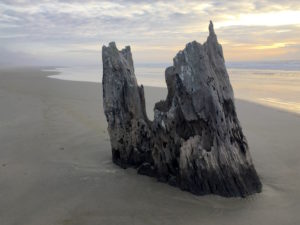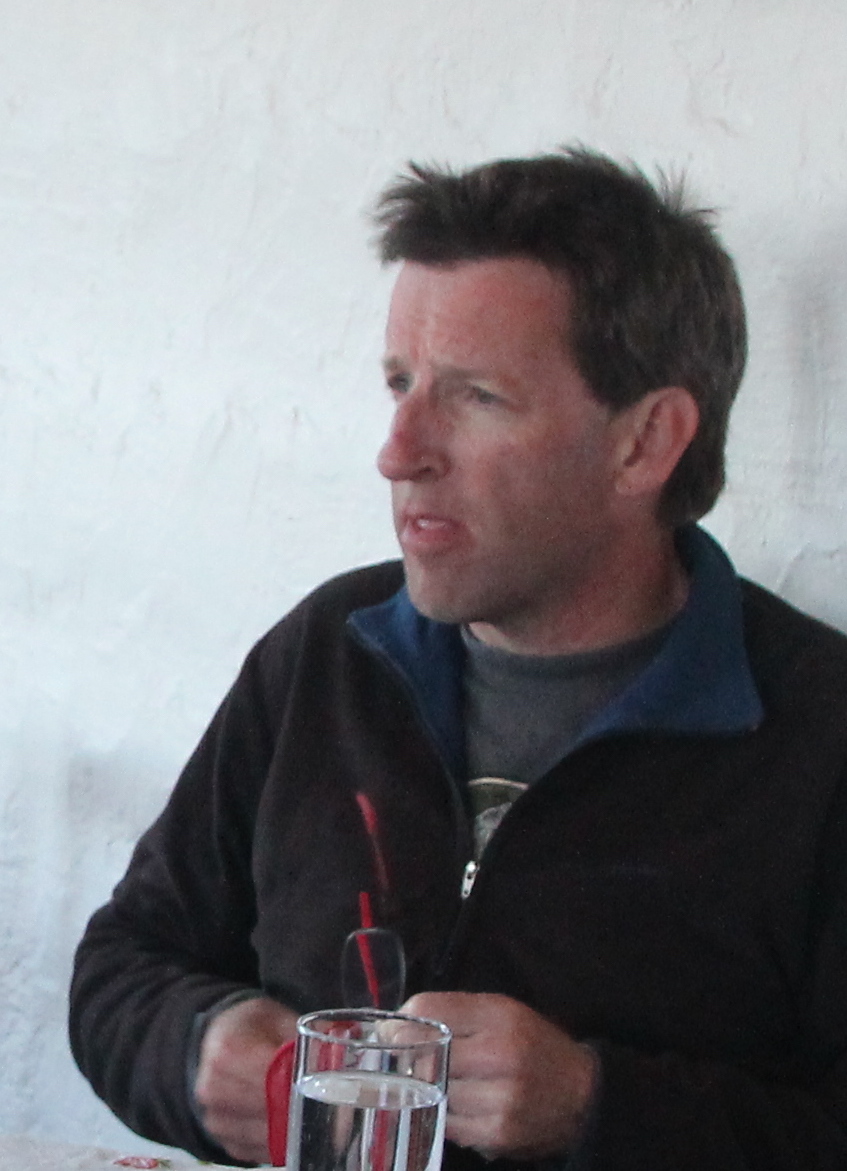 The first time I glimpsed it, the Big Stump from a distance loomed vaguely ahead like some oversized vacationer, perhaps some former football player out on the coast for a weekend of casual fun. But no. As I got closer I saw that it was taller and more wide-shouldered than even the biggest linebacker. It looked like a massive, solid block of dark wet wood and in the feathered mist only slowly resolved itself into a rounded and battlement-topped shape that was—or had been—a tree, a great cylinder now hollowed out after all these years.
The first time I glimpsed it, the Big Stump from a distance loomed vaguely ahead like some oversized vacationer, perhaps some former football player out on the coast for a weekend of casual fun. But no. As I got closer I saw that it was taller and more wide-shouldered than even the biggest linebacker. It looked like a massive, solid block of dark wet wood and in the feathered mist only slowly resolved itself into a rounded and battlement-topped shape that was—or had been—a tree, a great cylinder now hollowed out after all these years.
I’d heard about the Big Stump before—after all, this beach is named after it. Big deal, I thought at first. The beaches of the central Oregon coast are lousy with driftwood deposited by surf and storm, and even if I could somehow mentally overlook how it studs the sands with its countless dark masses my walk along the beach would zigzag between them anyway because of the way the dog so insistently wants to visit all of them, as that’s where the other dogs have left their scent messages.
The Big Stump was different, I’d heard. The Big Stump wasn’t a Big Log rolling in the surf—and some of these are impressive, giants four feet in diameter that have tumbled down some winter-swollen river before being parked out here in the sand. No, it was a Stump, and it stood Upright, and there was ample reason to believe that it not only once grew in a forest where there is now only sand, there was ample reason, too, to believe that it was a relic of a lost age.
That’s because it has been there a long time, showing up in the diaries and photographs of the earliest Anglo settlers around the turn of the last century, as well as in the oral traditions of Native Americans whose collective memory goes back much farther. The Stump was truly ancient, it was said. Whatever forest it once belonged to had disappeared from view long enough ago that it had been wiped clean away from all human memory.
Furthermore, it was said, the Stump was of redwood, and you have to travel something like 150 miles south before you find the northernmost redwoods growing today.
But 150 miles is a long way. Surely this tree had never grown on site, some said; surely it was just a quirk of storm and surf that this giant relic had traveled north on ocean currents, then been planted curiously upright by the action of waves. Maybe the culprit, some suggested, was a tsunami big enough to have implanted a giant log upright.
It was a mystery profound enough to capture the attention of some scientists from the University of Oregon who came out to the coast to poke and prod, measure and monitor. The report they produced had a pleasingly chunky title: “Potential Late-Holocene Disjunction of Sequoia sempervirens on the Central Oregon Coast.” The researchers reported that the gist of what local people had been saying was true. It was in fact a redwood, and it really had grown a long time ago; the scientists’ radiocarbon dates showed that the tree had died no fewer than 17 centuries ago. It had been alive at the same time as Jesus.
The questions about species and age now had definitive answers. What they couldn’t answer as certainly was how the Stump had gotten there. When they probed the sand with ground-penetrating radar they couldn’t find any evidence of ancient soil in which the tree had to have been rooted. Still, on balance they concluded the Stump was likelier a true relic of a vanished ancient forest on site—and evidence that redwoods once grew across a wider range than they do now—than a giant piece of driftwood lofted into an unlikely position by a long-ago tsunami.
I’m a visitor on this beach, more mildly curious than driven. Though I’m fascinated by the scientific puzzle-solving I kind of like the mystery, too. And what I really like is the knowledge that wherever this tree came from it stands today as a relic of a vanished something, a window into an ancient world.
In the places I know better, the canyons of northern Arizona, I love nothing more than spotting those same windows when I go hiking. Some years ago I got to venture up a largely hidden canyon on the Navajo Nation. It’s a deep slit in the sandstone of the Shonto Plateau, the sort of place where vertical canyon walls hundreds of feet high give way to flat wash bottoms containing winding and sandy streams.
It was July and hot, and the plateau tops and streamside hills were dotted with the piñons and junipers that are practically ubiquitous at that elevation. No surprise there.
But turn a wash corner and, up in an alcove from which a tiny stream ran, the sandstone wall was hidden behind a deep-green furring of Douglas fir. I scrambled up. The trees reached high into the shade of the canyon wall. In this almost-hidden nook, they’d rarely experience direct sunlight. It was cool in there, at least 10 degrees more comfortable than out in the sun. The ground was soft with fallen needles that overlay centuries of decomposed duff.
I was doing bird surveys back then, and my ears perked when in this tiny grove I heard the tinhorn beeping of a red-breasted nuthatch, a bird that usually lives in the spruce-fir forests about 3,000 feet higher in elevation. Somehow, this tiny songbird had found this patch of homey habitat far removed from others of its sort.
How long had the firs been growing here? Maybe since the cooler conditions at the end of the last Ice Age? I hoped so. I imagined how from the viewpoint of the trees, each growing centuries old, the surrounding landscape might have changed, growing just a bit drier and warmer within each tree’s lifespan, the spruces and firs further out on the landscape giving way to pine and juniper and cliffrose, the giant mammals of the Pleistocene dying out and being replaced by humans and sheep and cattle and, very recently, all the humans’ noisy machines.
The little grove, I came to think, was a sort of time machine, a relic of past times that, as long as it remained cool and moist and hospitable enough to host the Douglas-fir trees, still retained the ability to say something about the way things were. So is the Big Stump, threatened by the big storms of each winter but for now still standing. In a world of change that often seems too fast, it’s a comfort to find places that last longer than we expect.

